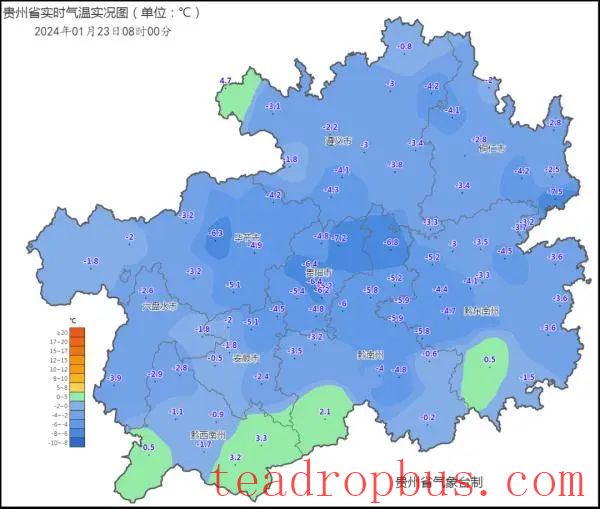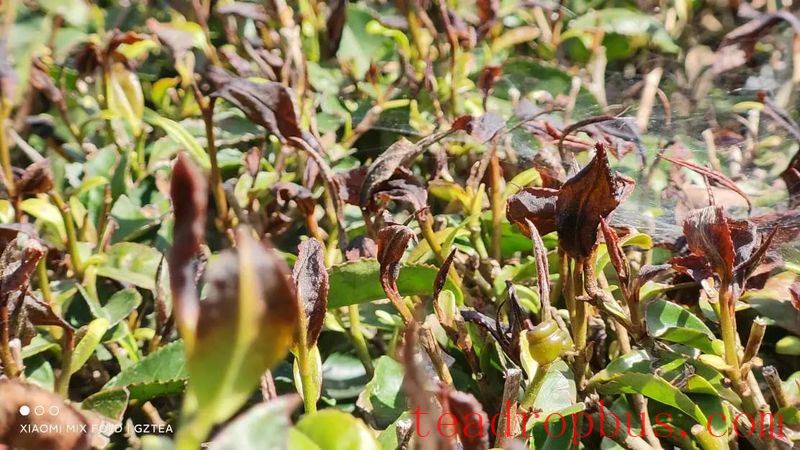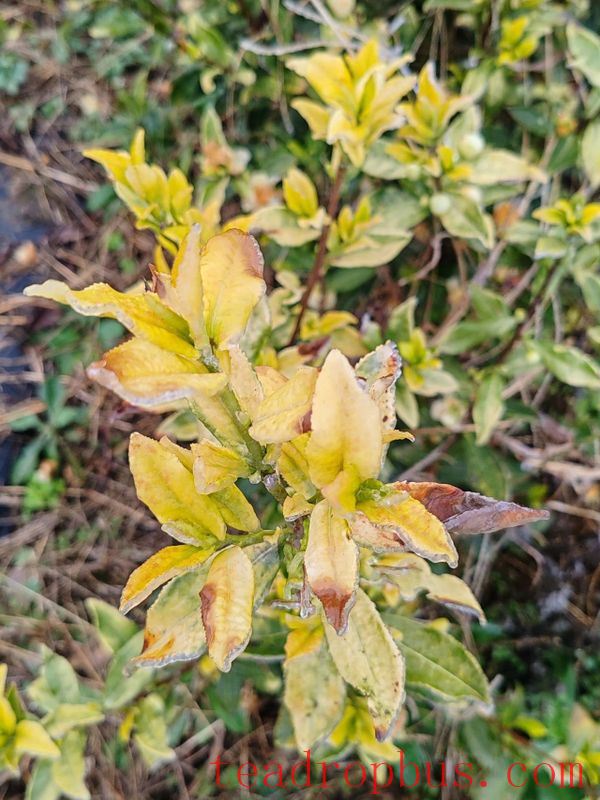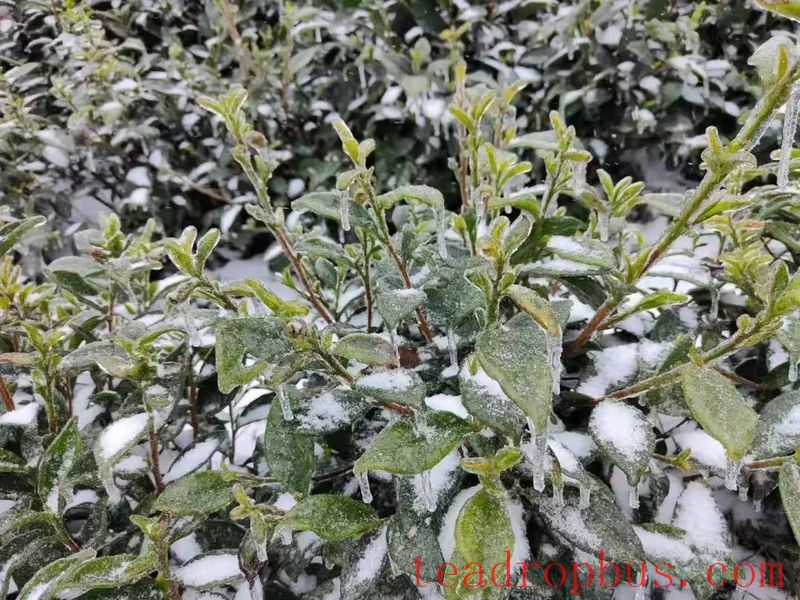Based on the latest meteorological data analysis, strong cold air began to affect our province from the 19th. This strong cold air has a wide impact, significant temperature drops, and prolonged low temperatures. From the 20th to the 25th, most areas of our province maintained temperatures below 0°C, experiencing severe cold and low-temperature snowy and freezing weather, making it very likely for Tea gardens to suffer from cold and frost damage.

To ensure tea production and mitigate the effects of cold and frost damage in tea gardens, based on the “Guidelines for Tea Production in Response to Low-Temperature Cold Weather” issued by the Planting Industry Management Department of the Ministry of Agriculture and Rural Affairs, the Zunyi Comprehensive Test Station of the National Tea Industry Technology System, the Guizhou Provincial Tea Industry Technology System, together with the Guizhou Academy of Agricultural Sciences Tea Research Institute, compiled measures for tea gardens to cope with low-temperature snowy and freezing weather, taking into account the situation in Guizhou. These are provided as a reference for agricultural management departments at all levels and tea growers in our province.
I. Hazards of Cold and Frost Damage to Tea Plants
The main types of cold and frost damage to tea plants in Guizhou include freezing, wind freezing, snow freezing, and frost. The cold resistance of different parts of the tea plant—buds, leaves, stems, and roots—increases in that order. Frost damage typically starts with the top branches and leaves, spreading from the leaf tips and edges to the center. In mild cases, this can cause redness in the tips of the buds and leaves; in severe cases, it can result in widespread browning and drying of the leaves, which significantly affects both yield and quality. Mature leaves lose their luster, curl up, and become brittle. In wet weather, they absorb water, causing them to swell and appear bloated. The damage then progresses to the stems, where late-growing, immature shoots are particularly vulnerable to drying and death. Young tea plants are susceptible to frost damage above the ground level of 8 to 10 cm. In mild cases, only the bark on the sunny side cracks and turns brown, while in severe cases, the bark on the shaded side dies, forming a dead ring around the trunk, leading to the death of the entire plant. Only under extremely cold conditions does root frost occur, manifesting as the outer bark turning brown and separating from the wood, or even falling off. Above-ground parts show delayed or uneven spring sprouting, and although some may still sprout, their growth is slow. In severe cases, new shoots gradually wither and dry out.

II. Protective Measures for Tea Gardens Against Cold and Frost Damage
(I) Deep Plowing and Earthing Up, Early Application of Heavy Base Fertilizer
Deep plowing at the end of autumn and beginning of winter loosens the soil, drains excess moisture, and promotes the extension of fine roots into deeper soil layers, enhancing cold resistance. Combined with fertilization and earthing up to retain heat, it reduces soil evaporation and conserves soil moisture around the roots, preventing freezing damage to the roots.
Tea picking should be stopped promptly at the end of autumn, followed by early and heavy application of base fertilizer. Based on factors such as the fertility of the tea garden's soil and the age of the tea plants, a reasonable combination of manure, commercial organic fertilizers, commercial organic-inorganic compound fertilizers, and commercial compound fertilizers should be applied. Fertilization should be carried out when above-ground growth stops (generally between late October and early December). In regions with higher altitudes and lower temperatures, where tea plants stop growing earlier, the timing of fertilization should also be advanced accordingly.

(II) Pay Attention to Cold Snap Forecasts and Take Timely Measures to Prevent Frost Damage
Closely monitor local weather forecasts to stay informed about agricultural weather hazards. Tea gardens, especially nurseries, young gardens, and high-altitude mountainous tea gardens, should take preemptive measures in preparation for low-temperature cold snaps.
(III) Implement Covering and Barrier Measures to Shield Against Wind and Keep Warm
Tea nurseries, young gardens, and high-altitude mountainous tea gardens should implement appropriate protective measures, such as covering the tea canopy, inter-row covering, and setting up barriers, to minimize the harm caused by extreme low temperatures to the tea garden and ensure the production of Spring Tea the following year. In mountainous tea gardens, cover crops can be planted in the fall to cover the ground and increase soil temperature. Alternatively, locally sourced materials like straw and stalks can be spread between rows to raise the ground temperature of the tea garden and reduce the extent of frozen soil. For tea gardens prone to frost on the windward side, establishing windbreaks can reduce wind speed within the area and protect against cold snaps. Tea canopies can also be covered with straw, weeds, or shade nets, which should be removed after hazardous weather conditions have passed.
(IV) Apply Anti-Cold and Anti-Freeze Agents or Antibiotics
After receiving warnings of low-temperature cold snaps and freezing weather, choose a day without rain to apply anti-cold and anti-freeze agents to the plants to enhance their resistance. Antibiotics can also be applied to inhibit ice-nucleating bacteria to achieve a frost prevention effect.
(V) Promptly Clear Ditches, Remove Ice, and Clear Snow
For plots located in low-lying areas with poor drainage, ditches should be promptly cleared and additional drainage ditches dug to prevent the accumulation of water after snow and ice melt, which can cause freeze damage to the roots of tea plants. For mountainous tea gardens with heavy snowfall, once the temperature rises, the accumulated snow on the tea canopy should be promptly removed to reduce the occurrence of frost damage.


III. Post-Frost Management Measures for Tea Plants
(I) Timely Pruning
For tea gardens affected by frost, pruning should be performed after the temperature rises in the spring, before the buds start to sprout. The depth of pruning should be determined according to the severity of the frost damage, with the cut made 1 to 2 centimeters deeper than the damaged part, ideally 1 to 2 centimeters above the branch fork. If only the edges of the leaves were affected by the frost, no pruning is necessary.
(II) Shallow Cultivation and Fertilization
After pruning frost-damaged tea plants, strengthen nutrient and water management by applying early spring sprouting fertilizer. Fertilization should generally be done before the end of February, with fast-acting chemical fertilizers as the main type. On top of nitrogen fertilizers, phosphorus and potassium fertilizers should be added, and if possible, organic fertilizers should be used as well.
(III) Retaining and Strengthening Damaged Canopies
In terms of picking methods for the following year, tea gardens affected by frost should focus on retaining new shoots. For tea gardens with light frost damage, one true leaf should be left during spring picking. For those with more severe frost damage, the focus should be on nurturing, ensuring the retention of productive branches and the recovery of the canopy.
Zunyi Comprehensive Test Station of the National Tea Industry Technology System
Guizhou Provincial Tea Industry Technology System
Guizhou Academy of Agricultural Sciences Tea Research Institute
January 23, 2024
Source: Guizhou Academy of Agricultural Sciences Tea Research Institute, Guizhou Tea Society, information shared for its value,